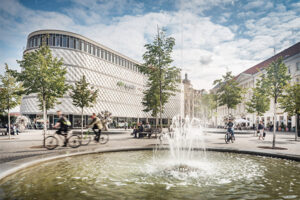BY RAINER KUNDÖRFER
Key barriers to refurbishment as a real factor in center development are an unwillingness among owners and banks to write down the current value of centers, constructional limitations, poor reputations, and a lack of “sex appeal.” It is feared that all the effort will yield nothing new in the end and that there will be no accolades to be had. That does not exactly sound like a success story. I am still convinced that success stories can be written about refurbishment, however. With a holistic approach in the right location and attention to detail, many rusty bits of iron can be made to shine once again. After all, everyone has experienced it before: “love at second sight.”
In an overall view of the process, I would like to highlight the role of tenants or retailers. In many discussions and in an active advisory role, I generally sense little willingness among retailers to get intensively involved with troubled locations.
I understand the need to do the right thing right. Efficiency and effectiveness determine our actions. Who would want to take an economic risk on a site or shopping center with unmotivated staff and a bad reputation? Not to mention the loss of image involved in taking on such a risk when, at first glance, there is nothing to be gained from it. So people wait and see. Someone will do something. When someone finally does take the time, they look for a risk-free agreement and wait to see what happens. When nothing happens, they bail out without commitment. This is not what entrepreneurial thinking looks like.
Shouldn’t the basic idea and drive of the “expansionists” still be a willingness to change and to seek and find opportunities? Or have companies’ structures and requirements changed so much that only ripe fruit to the right and left of the well-beaten path should be picked from the car in passing?
Unfortunately, most of that “low-hanging” fruit has already been harvested – only very rarely is anything left within the comfort zone. For me, expansion goes beyond sound economic thinking towards anticipating and creatively shaping possibilities. Finding new ways should be the goal. We need decision makers who think laterally and also display assertiveness in both directions at the right moment.
The times when expansion was about going to the lessor’s office, via the broker, to sign a new lease are over. In the prevailing market environment, retailers should take a close look at every opportunity and analyze it in detail.
Refurbishment provides this opportunity. This requires the willingness of all process participants and does not exclude decision makers among users and retailers. They should be actively involved and should involve themselves, without just opportunistically opening their hands when the situation allows. “Win win” situations do not arise this way. This must be accompanied by a willingness among center operators to change things fundamentally and to compromise with their partners – the users.
Let’s convince those who ultimately determine success with sustainable refurbishment: the consumers.
What is your opinion on this topic? Discuss it with us! Send your opinion to opinion@across-magazine.com !






